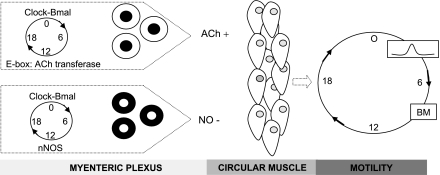Fig. 3.
Conceptual model for circadian regulation of colonic motility. The rhythmic expression of clock genes within the neurons of the myenteric plexus modulate colonic motility through direct or indirect clock-controlled transcription of genes such as acetylcholine (ACh) transferase and neuronal nitrix oxide synthase (nNOS). Direct clock-controlled transcription can be mediated through an E-box element (the consensus sequence for the E-box element is CANNTG) through which clock genes can enhance transcription of downstream gene. Transcription of ACh and nNOS will lead to the rhythmic release of ACh and nitric oxide (NO), which will initiate diverse biochemical, cellular, and physiological processes within the colonic circular muscle, which may in turn, through a cascade of second order messengers and various signaling pathways lead to enhanced colonic motility and, eventually, a bowel movement (BM) at one time of the day and decreased colonic motility at another time of day.

